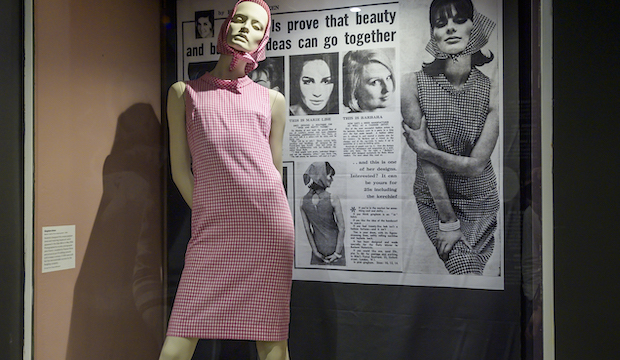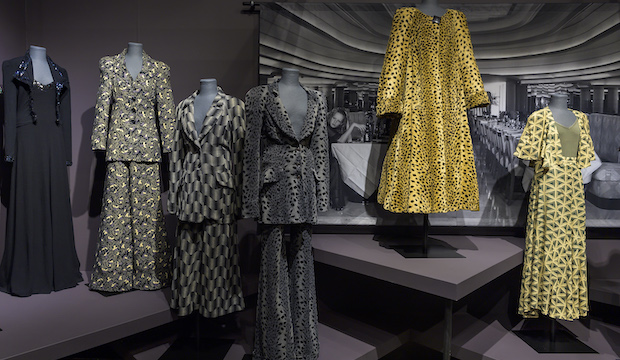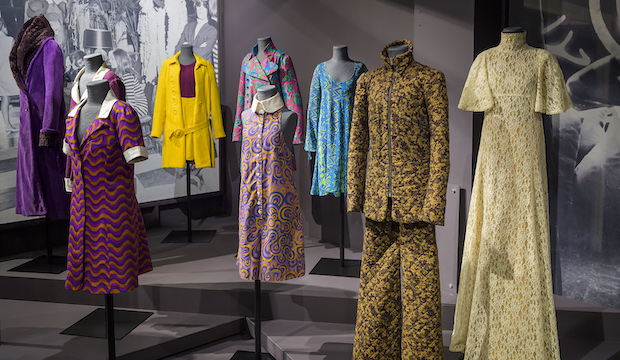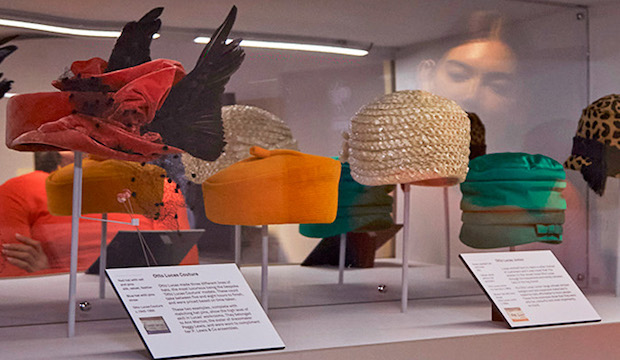The Biba Story, 1964-75 review ★★★★★
Mini-skirts, psychedelic prints, baked beans.... For 11 heady years, it was all go at Biba. And in the East End, workrooms kept London dressed
Twiggy reclining in Biba, c 1973. Photo: Justin De Villeneuve/Iconic Images
Do you see yourself in a pink gingham shift with matching scarf? Maybe not. Or a floor-length black chiffon dress with sheer neckline? Definitely. The fashions crafted by Barbara Hulanicki for the fashion bubble that was Biba are both crankily dated, in an exhibition at the Fashion and Textile Museum, Bermondsey, and achingly desirable.
Among the 50 or so outfits salvaged since the first days of Biba in 1964 to its collapse in 1975, are items from the cheap and cheerful to the couture range that turned heads. For the latter, customers could choose by mail order, in those days before online shopping, their preferred style from a range, supply their measurements, and wait for their made-to-measure garment to arrive in the post.
But at the heart of the Biba dream was affordable street fashion that was a liberation for young women on small incomes, possibly in first jobs, but with somewhere to go at the weekend, and in need of something to wear.

Where it all began: a pink gingham frock for next to nothing. Photo: Fashion and Textile Museum
Today we are accustomed to clothing at sometimes shockingly low prices – we have to ask who made this snip of a garment, how old are they, how much were they paid? But Biba was breaking new ground, buying a few bolts of fabric over the counter, running them up into outfits that would cost 25 shillings, equivalent today to £20.
Hulanicki was a talented fashion illustrator, contributing in the 1950s to Vogue, Tatler and the influential Women's Wear Daily. That breakthrough, Brigitte Bardot-inspired, pink gingham number was hailed in the Daily Mail in 1964, which drew attention to her burgeoning mail order business. By February 1966 she had opened her first shop, on the site of a disused pharmacy in Abingdon Road, a quiet residential road off Kensington High Street that suddenly found itself a magnet for dedicated followers of fashion.
Styles sold out so quickly that customers needed to check back almost daily for the new look. But Dior's big-skirted New Look this was not. In 1964 André Courrèges showed what would be dubbed the mini-skirt, a style quickly adopted by Mary Quant – and Hulanicki. The pencil-thin cut for a boyish figure, cut on or above the knee saved on fabric, and garments came in sizes 8 to 14 only – and this before 'sizeflation': a size 14 dress had a bust of about 35in, compared with today's 39in or so.

The Biba story encompasses evening wear, trouser suits and coats. Photo: Fashion and Textile Museum
Not since the 1920s had women had the freedom of movement that came from slipping into a simple, straight-lined frock. Clothes were flying out of the store, and a Brighton shop quickly opened, but attracted an undesirably raffish crowd at odds with Biba's bright image.
Nippy designs were made up in what Hulanicki dubbed 'Auntie colours': purple, brown, mauve, black and plum. These were a tribute to her Aunt Sophie, the sister of her father Witold, who had been murdered in 1948. Hulanicki would go on to name her own child, with her husband and business partner Stephen Fitz-Simon, Witold. But this dense palette also referenced favourite artists and designers – Gustav Klimt, Alphonse Mucha and Charles Rennie Mackintosh.
At the Fashion and Textile Museum, The Biba Story, 1964-75 marks 60 years since the launch of Biba, with its distinctive gold on black Celtic knot logo. There are more than 50 garments or outfits on display, spanning the dizzying 11 years of Biba's rise and fall. While the more psychedelic shift dresses and two pieces are very much of their time, others remain classics.

Plum tones were dubbed 'Auntie colours'. Photo: Fashion and Textile Museum
Several are loaned by Biba's first shop manager, Sarah Plunket, who had the foresight to hang on to what was essentially the first throw-away fashion. Biba was practical: clothes were designed by a woman, for women. 'We are determined that customers shall be able to buy summer clothes in summer and autumn clothes in autumn,' said Hulanicki, in defiance of normal retail practice.
'I always tried to get prices down, down, down,' was her mantra. But she was canny too: she opened every store in the winter, to help sales of warm coats, which had a higher profit margin.
At its peak, Biba, in Kensington High Street, turned over £200 per square foot compared with £50 per square foot in a department store. Customers poured through the door in an everlasting stream. 'Black sells so quickly it usually looks as though we don't stock it,' observed Hulanicki.
When Big Biba opened off Kensington High Street in Derry Street, on the site of the old department store Derry and Toms, the sky was the limit – almost literally. On the roof terrace was a garden with flamingoes, and below were floor after floor of designs for living both desirable and fantastical. Now you could buy not only clothing but homeware and food, right down to Biba baked beans.

Meticulous craftsmanship from London's workrooms: a display at 'Fashion City', Museum of London Docklands
By 1975 this empire was largely owned by commercial property developers British Land. Hulanicki didn't like the direction of travel, left and Biba crumbled. It wasn't the end of affordable fashion: others were waiting in the wings. As the Museum of London Dockands' enthralling Fashion City exhibition illustrates so vividly, migrants to the East End in particular, many of them Jewish families, designing and making eye-catching garments.
While the Biba exhibition does not venture into the workroom, Fashion City goes behind the scenes, and also revels in the crossover between the fashion and pop world. A visit to both is recommended, to fully appreciate the post-war clothing boom that underpins today's fast fashion.
The Biba Story, 1964-75 is at the Fashion and Textile Museum, Tues to Sun, until 8 Sept. Fashion City is at the Museum of London Docklands, East India Quay, Mon to Sun, until 7 July
Among the 50 or so outfits salvaged since the first days of Biba in 1964 to its collapse in 1975, are items from the cheap and cheerful to the couture range that turned heads. For the latter, customers could choose by mail order, in those days before online shopping, their preferred style from a range, supply their measurements, and wait for their made-to-measure garment to arrive in the post.
But at the heart of the Biba dream was affordable street fashion that was a liberation for young women on small incomes, possibly in first jobs, but with somewhere to go at the weekend, and in need of something to wear.

Where it all began: a pink gingham frock for next to nothing. Photo: Fashion and Textile Museum
Today we are accustomed to clothing at sometimes shockingly low prices – we have to ask who made this snip of a garment, how old are they, how much were they paid? But Biba was breaking new ground, buying a few bolts of fabric over the counter, running them up into outfits that would cost 25 shillings, equivalent today to £20.
Hulanicki was a talented fashion illustrator, contributing in the 1950s to Vogue, Tatler and the influential Women's Wear Daily. That breakthrough, Brigitte Bardot-inspired, pink gingham number was hailed in the Daily Mail in 1964, which drew attention to her burgeoning mail order business. By February 1966 she had opened her first shop, on the site of a disused pharmacy in Abingdon Road, a quiet residential road off Kensington High Street that suddenly found itself a magnet for dedicated followers of fashion.
Styles sold out so quickly that customers needed to check back almost daily for the new look. But Dior's big-skirted New Look this was not. In 1964 André Courrèges showed what would be dubbed the mini-skirt, a style quickly adopted by Mary Quant – and Hulanicki. The pencil-thin cut for a boyish figure, cut on or above the knee saved on fabric, and garments came in sizes 8 to 14 only – and this before 'sizeflation': a size 14 dress had a bust of about 35in, compared with today's 39in or so.

The Biba story encompasses evening wear, trouser suits and coats. Photo: Fashion and Textile Museum
Not since the 1920s had women had the freedom of movement that came from slipping into a simple, straight-lined frock. Clothes were flying out of the store, and a Brighton shop quickly opened, but attracted an undesirably raffish crowd at odds with Biba's bright image.
Nippy designs were made up in what Hulanicki dubbed 'Auntie colours': purple, brown, mauve, black and plum. These were a tribute to her Aunt Sophie, the sister of her father Witold, who had been murdered in 1948. Hulanicki would go on to name her own child, with her husband and business partner Stephen Fitz-Simon, Witold. But this dense palette also referenced favourite artists and designers – Gustav Klimt, Alphonse Mucha and Charles Rennie Mackintosh.
At the Fashion and Textile Museum, The Biba Story, 1964-75 marks 60 years since the launch of Biba, with its distinctive gold on black Celtic knot logo. There are more than 50 garments or outfits on display, spanning the dizzying 11 years of Biba's rise and fall. While the more psychedelic shift dresses and two pieces are very much of their time, others remain classics.

Plum tones were dubbed 'Auntie colours'. Photo: Fashion and Textile Museum
Several are loaned by Biba's first shop manager, Sarah Plunket, who had the foresight to hang on to what was essentially the first throw-away fashion. Biba was practical: clothes were designed by a woman, for women. 'We are determined that customers shall be able to buy summer clothes in summer and autumn clothes in autumn,' said Hulanicki, in defiance of normal retail practice.
'I always tried to get prices down, down, down,' was her mantra. But she was canny too: she opened every store in the winter, to help sales of warm coats, which had a higher profit margin.
At its peak, Biba, in Kensington High Street, turned over £200 per square foot compared with £50 per square foot in a department store. Customers poured through the door in an everlasting stream. 'Black sells so quickly it usually looks as though we don't stock it,' observed Hulanicki.
When Big Biba opened off Kensington High Street in Derry Street, on the site of the old department store Derry and Toms, the sky was the limit – almost literally. On the roof terrace was a garden with flamingoes, and below were floor after floor of designs for living both desirable and fantastical. Now you could buy not only clothing but homeware and food, right down to Biba baked beans.

Meticulous craftsmanship from London's workrooms: a display at 'Fashion City', Museum of London Docklands
By 1975 this empire was largely owned by commercial property developers British Land. Hulanicki didn't like the direction of travel, left and Biba crumbled. It wasn't the end of affordable fashion: others were waiting in the wings. As the Museum of London Dockands' enthralling Fashion City exhibition illustrates so vividly, migrants to the East End in particular, many of them Jewish families, designing and making eye-catching garments.
While the Biba exhibition does not venture into the workroom, Fashion City goes behind the scenes, and also revels in the crossover between the fashion and pop world. A visit to both is recommended, to fully appreciate the post-war clothing boom that underpins today's fast fashion.
The Biba Story, 1964-75 is at the Fashion and Textile Museum, Tues to Sun, until 8 Sept. Fashion City is at the Museum of London Docklands, East India Quay, Mon to Sun, until 7 July
TRY CULTURE WHISPER
Receive free tickets & insider tips to unlock the best of London — direct to your inbox
| What | The Biba Story, 1964-75 review |
| Where | Fashion and Textile Museum, 83 Bermondsey St, London, SE1 3XF | MAP |
| Nearest tube | London Bridge (underground) |
| When |
22 Mar 24 – 08 Sep 24, Tues to Sun. Last admission 17:15PM. Allow 1hr 30min |
| Price | £12.65 |
| Website | Click here for details and booking |